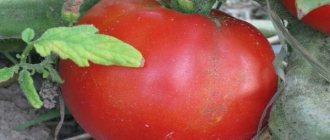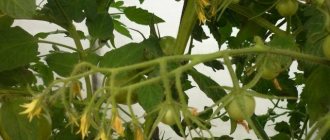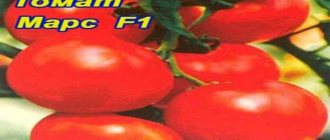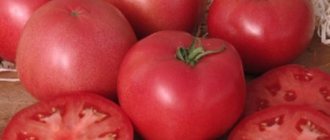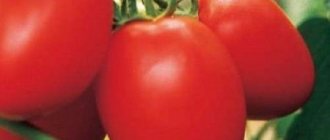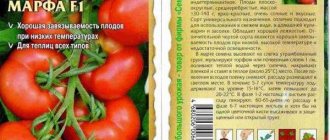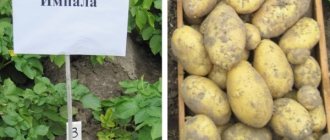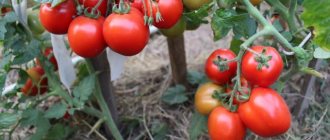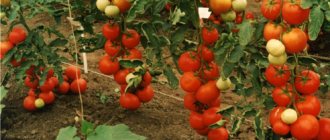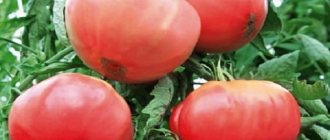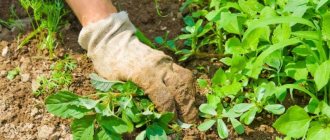| Ripening period: | mid-season |
| Shape, weight of fruits: | flat-round, slightly ribbed, weight 78-112 g (up to 250 g) |
| Bush type: | determinant |
| Growing regions: | North Caucasian |
| Productivity: | 2.5-6 kg per 1 sq. m. |
Often, gardeners from the mass of different tomato varieties for cultivation in their beds choose low varieties of tomatoes with uniform, medium-sized fruits. Many people like this particular shape and size. The Impala tomato meets these characteristics.
Characteristics and description of the variety
The mid-season hybrid Impala F1 was registered in the State Register of the Russian Federation in 2009. Designed for cultivation in the North Caucasus region in open beds. Determinate bush, fruits for salad purposes.
Description of the hybrid variety:
- plant height in beds is 0.7 m, in a greenhouse – up to 1 m;
- leaf is medium and large, dark green in color;
- simple inflorescence;
- stalk with articulation;
- tomatoes are flat-round, with dense pulp, slightly ribbed;
- the fruit is green during ripening, after ripening it is red;
- number of chambers with seeds – 4-6;
- the taste is excellent.
The yield of the Impala hybrid is 2.5-6 kg per square meter. m. The yield of marketable fruits is 86-99%.
The average weight of a tomato is 78-112 g (up to 250 g). Ripe tomatoes can be used to prepare various dishes, vegetable salads, pickled and salted in barrels, and made into tomato paste or juice. The photo shows a typical plant of this hybrid.
Features of agricultural technology and reviews
Impala tomatoes are grown through seedlings with further movement of the plants into prepared soil in the garden or greenhouse structure. In the south of the country, these tomatoes are often cultivated in open areas. But in regions with a cool climate, the use of greenhouses is quite justified to obtain high yields.
Tomato bushes form 1-2 stems. They usually do not require a garter. But if there are a lot of fruits on a tomato, it is better to play it safe and tie up the plant.
Advice. It is recommended to plant no more than 5-6 bushes per 1 m².
Gardeners give the Impala tomato good reviews:
- Marina Anatolyevna from Moscow had her first experience in planting tomatoes, which turned out to be successful. Her whole family appreciated the taste of the Impala F1 fruits, which were used for salads and juicing.
- Natalia Evgenievna from Voronezh also liked the variety. The plants did not get sick, and the tomatoes turned out to be large and tasty. They were moderately sweet without being overly sugary.
- Igor Petrovich from Tver, who grows tomatoes for sale, also grew large and juicy tomatoes. He tries different varieties and has only good things to say about the Impala hybrid.
Productive, tasty, suitable for harvesting and fresh consumption - all these qualities make Impala tomatoes very attractive in the eyes of gardeners. Tomato is especially well suited for beginning gardeners, as it is unpretentious to care and weather conditions.
Timing of seed sowing and cultivation
Tomato Impala F1 is grown mainly through seedlings. Due to the fact that tomatoes grow for some time in a warm room, their growing season in the beds is shortened. This makes it possible to get a harvest much earlier than if the plants grow in the ground from seeds.
Sowing of seedlings is carried out in March - early April. The plants will reach the desired height in May, and then they will need to be planted in the beds.
Impala tomatoes are grown in seedling boxes or in plastic cups and pots. A volume of 0.3 liters will be sufficient.
You can prepare the soil yourself (mix turf soil with coarse sand and well-rotted humus) or buy the substrate in vegetable growing stores. Seeds must be taken fresh; the expiration date can be found on the packaging.
The seedling depth is no more than 1.5 cm. After sowing, they are sprinkled with substrate and lightly watered.
The pots are placed in a place that is not very well lit and covered with transparent film. When the seedling loops appear, the covering material can be removed. Then the pots are transferred to the brightest place, for example, on a windowsill.
The suitable temperature for growing tomatoes is about 22˚C during the day and slightly lower at night.
During the growth period, seedlings need fertilizers and irrigation. They feed it at intervals of 1.5-2 weeks, water it approximately every 3-4 days. There is no need to pour a lot of water; due to waterlogging, seedlings often suffer from blackleg. It is convenient to feed with a solution of mineral fertilizers with microelements.
From organic matter, you can pour non-concentrated manure infusion (1 to 10) with the addition of 0.5-1 tbsp. ash per 10 l. 50-100 ml of liquid is poured under each plant.
7-10 days before transplanting, seedlings need to be hardened off. It is taken out into fresh air and left there first for 10-20 minutes, then gradually increase the residence time to 10-12 hours.
Growing
It is recommended to grow the Baba tomato in seedlings. The variety is light-loving, so it is better to place beds for planting seedlings in open areas of the garden. Tomatoes are not picky about soil and can grow in almost any soil. But the best fruiting is observed on light soil.
Comment! Growing Baba tomatoes in the shade will directly affect yield indicators. Tomatoes grown on such plants will be smaller in size compared to fruits ripened on bushes in sunny areas.
Growing seedlings
The timing of sowing seeds for seedlings depends on the region where tomatoes are grown. The exact date must be calculated individually, focusing on the possible time of planting seedlings in the ground. Seedlings are considered ready for transplanting at the age of 2 months, so in the middle zone it is recommended to sow seeds in the first ten days of March.
Sowing should be carried out in specially prepared containers for seedlings. The seeds must first be disinfected in a weak manganese solution. Then they must be washed in clean water.
Advice! You can speed up the germination of seeds by soaking them for 10-12 hours in solutions that stimulate growth, such as Epin, Kornevin, Zircon.
Crops should be created with comfortable conditions for growth, in particular, the room temperature should not be lower than 22 °C. During the growth process, seedlings are recommended to be fed periodically. In the phase of formation of the first pair of true leaves, the seedlings are planted in separate containers (pots, cups). A week before transplanting into the ground, the seedlings begin to harden. Such procedures will help plants quickly adapt to new conditions.
Landing rules
At the end of April and beginning of May, the strengthened seedlings are transplanted into open or closed ground. The landing site must first be prepared. The beds are carefully dug up and fertilized with organic fertilizers, for example, fresh manure.
The recommended density of seedlings per area is 3-4 pcs. per 1 m2. The distance between the bushes should be at least 0.4-0.5 m.
Watering and fertilizing
Watering Baba tomatoes requires moderate watering. Excessive moisture can significantly reduce yields and lead to root rot.
It is important to monitor the frequency of watering during the ripening period of tomatoes, reducing them as necessary.
Comment! It is necessary to water the plants with warm, settled water. Cold weather can slow down the growth of bushes and lead to the development of diseases.
An equally important care procedure is feeding tomatoes. You can use both mineral and organic fertilizers with a high potassium content
Pinching and tying
Baba tomatoes need to be tied to a support. It is imperative to fix both the main stem and the side branches so that they do not break off under the weight of the ripening fruits. In order for the bushes to use up their supply of nutrients as efficiently as possible, it is necessary to regularly remove the stepsons. Otherwise, all the plant’s forces will be directed to the formation of multiple peduncles that are not able to fully ripen.
Advice! The ripening of fruits can be prevented by foliage shading them. Removing such leaves can significantly delay harvest time.
It is recommended to start planting Baba tomatoes in July. The frequency of the procedure is once every 10-14 days.
Formation
The formation of a bush is a mandatory procedure to maximize the yield of Roma Baba tomatoes. The most optimal way is to grow tomatoes with 1-2 stems.
Protection from diseases and pests
The Baba tomato is highly resistant to diseases and pests, like many other mid-season varieties. But sometimes improper care can lead to the development of fungal diseases such as:
- late blight;
- blackleg;
- powdery mildew.
They appear in the form of various spots and damage on fruits and leaves, which can not only reduce productivity, but also lead to the complete death of plants. To combat fungal diseases, fungicidal preparations are used in the form of preventive treatments. Spraying begins after planting the seedlings in the ground, repeating at the frequency recommended by the manufacturer. Thus, it is possible to prevent the development of infection in the early stages of development.
To combat harmful insects, it is recommended to use insecticides. Liquid preparations are used in the form of sprays. Dry granules or powder are scattered around the tomato bushes.
Planting in the ground and care
Despite the fact that Impala F1 tomatoes are compact, it is not recommended to plant them densely. Per sq. m area should be placed no more than 4-5 bushes. They are planted in holes, buried up to the root collar.
After planting, water, sprinkle with soil and cover with mulch. It is recommended to use it to ensure that the soil does not dry out, is fluffy, and to prevent the growth of weeds. If a cold snap is expected, the beds are covered with film.
Watering regime - until rooting, every day or every other day, then the frequency should be reduced so as to keep the soil moist regularly.
Tomatoes require a lot of water when the fruits are filling, but after most of them have formed, watering should be limited and then stopped completely so that they do not crack.
Water the plants at the roots; liquid should not get on the leaves. Irrigation time is evening or early morning, when the temperature drops, the sun does not burn the leaves. Use only warm, settled water.
Carry out at least 3 feedings per season: shortly before flowering, after it and during the phase of mass fruit growth. Nitrogen, phosphorus and potassium fertilizers are used. The first feeding is carried out with saltpeter, urea (1 tablespoon per bucket of water), then superphosphate, potassium salt, potassium sulfate or any other fertilizer with a high content of phosphorus and potassium. The proportions for preparing the solution are indicated in the instructions for the preparations.
The Impala F1 tomato is formed into 2 or 3 stems, that is, in addition to the main trunk, 1 or 2 more lower stepsons are left, from which the rest will be formed. Newly appearing stepsons are pinched off, preventing them from growing back much. The lower leaves should also be trimmed after wilting and yellowing.
Plants do not need to be tied up, but if they bend under their weight, they need to be supported. The fruits should not touch the ground so as not to rot.
Impala tomatoes ripen within the time specified by the breeders, but in rainy and cool summers ripening may be delayed.
Harvest as soon as the tomatoes ripen. Their skin and pulp are dense, the fruits tolerate transportation and short-term storage well.
Varietal characteristics
Tomatoes of the Impala F1 variety are a medium-early ripening hybrid. The harvest is usually harvested in late June, however, the fruits ripen unevenly. The exact timing is calculated from the moment the seeds are planted for seedlings - the first tomatoes ripen approximately on the 95th day (65th from the moment the seedlings are transplanted into open ground).
The variety demonstrates good fruit set regardless of weather conditions. The yield of tomatoes is consistently high - from 3 to 4 kg per plant.
The hybrid is resistant to many fungal and infectious diseases. In particular, Impala F1 is rarely affected by the following diseases:
- brown spot;
- gray spotting;
- fusarium;
- cladosporiosis;
- verticillium.
Pests rarely attack tomato beds, so there is no particular need for any special preventive measures. On the other hand, spraying plantings against fungus will not be superfluous.
Important! Impala F1 tomatoes are a hybrid variety. This means that independently collecting seeds for seedlings will not be productive - such planting material does not fully preserve the varietal qualities of the parent bushes.
The germination of seeds of the Impala F1 variety is maintained for 5 years.
Pros and cons of the variety
Tomatoes of the Impala F1 variety have many advantages, which sets the hybrid apart from other species. It is especially attractive for beginners in gardening. The reason for this is the following qualities of tomatoes:
- relative ease of care;
- high resistance to drought;
- resistance to most diseases typical of tomatoes;
- consistently high yields regardless of weather conditions;
- good transportability - the skin of the fruit does not crack during long-distance transport;
- resistance to sunburn, which is achieved due to the density of the foliage;
- long shelf life of the crop - up to 2 months;
- rich fruit aroma;
- moderately sweet taste of the pulp;
- versatility of fruit use.
The only pronounced drawback of tomatoes is their origin - Impala F1 is a hybrid, which leaves an imprint on possible methods of reproduction. You can collect the seeds of the variety manually, however, when sowing such material, the yield will decrease significantly, and many of the qualities of the tomatoes will be lost.
Advantages and disadvantages
The plants are low and do not need staking or shaping. Many vegetable growers consider these characteristics important when choosing a variety to grow.
Tomato Impala F1 is drought-resistant, good foliage protects the fruits from burns. The skin of tomatoes is not thick, but dense and durable, thanks to this they can be transported over long distances, they do not wrinkle or crack on the bushes when watering and during canning from hot water.
Tomatoes, sweet and tasty, can be stored for quite a long time if they are kept in a cool, dark place.
The only drawback of Impala F1 is that you cannot collect your own seeds, because it is a hybrid. They must be purchased again every season.
Opinions of summer residents regarding Impala tomatoes
Reading reviews from gardeners you can find a lot of useful information. People share their own experiences and recommend things.
- Maria. An attempt to grow tomatoes on the plot turned out to be very successful. The fruits grew large and very tasty. The whole family enjoyed eating straight from the bushes. They will definitely grow more.
- Natalya Nikolaevna. The formation of the bush led to the fact that the fruits grew very large. About 250 gr. Fed with organic matter 4 times. All liked it. They will plant more.
“Impala” is a large-fruited tomato; many summer residents love it for its rich taste and resistance to adverse conditions.
Similar hybrids
In terms of characteristics and descriptions, the following hybrids are close to the Impala tomato:
- Blagovest;
- Kate;
- Lyubasha.
The tomato hybrid Blagovest F1 is an early-ripening crop with a ripening period of 101-105 days after emergence. It has a semi-determinate type of bushes up to 1.8 m high. The red fruits weigh on average 100-110 grams. The variety is resistant to many diseases common to tomatoes.
Katya F1 is a determinate hybrid with a height of no more than 1.2 m. The fruits of the plant have a bright red color and thick skin. The average weight of one tomato is 110-130 grams.
The Lyubasha tomato is an ultra-early hybrid with a ripening period of 80-85 days. The plant is low-growing, up to 70 cm high. The red fruits of the crop do not exceed 140 grams in weight. Suitable for growing in open and protected ground.
Description of culture
Tomato Impala F1 is a mid-early hybrid from French breeders. Manufacturer: Vilmorin company. Suitable for cultivation in most regions of our country. Designed for open ground, as well as for growing in greenhouses or using temporary film shelters.
General description of tomato:
- The tomato bush is low, compact in shape, determinate type, well leafy, with short internodes.
- The inflorescence is simple.
- The fruits are aligned, uniform in size, usually larger at the bottom of the bush. Ripe tomatoes are bright red in color and aromatic.
- The taste of the fruit is rich, moderately sweet, but without excess sugar. The tomato pulp is medium dense, juicy, and the skin is not prone to cracking.
- They are used for canning, making juice, fresh salads, processing into pasta and sauces.
- The appearance of the plant and fruits can be seen in the photo, and the main characteristics of this hybrid are presented in the table.
According to ripening time | By type of growth | By type of use | By growing method | Fruit weight (g) | Productivity (kg/m2) | Fetal characteristics |
| Mid-early (95-110 days) | Determinant (60-100 cm) | Universal | For open ground, greenhouses, film shelters | 180-200 | Greenhouse - up to 20-24 kg, garden bed - about 15 kg | Red. Moderately dense, with strong skin. 3-5 pieces per brush |
How to plant and care
- The variety is grown from seedlings. Sowing of seeds is carried out 60 days before transferring the plant to a permanent place.
- When the seedlings have two leaves, they are transplanted into separate containers.
- Ten days before planting in the garden, hardening off the plant should begin. Thanks to this, the tomatoes will gain strength and better withstand stress.
- To harden tomatoes, seedlings should be taken out into the open air, in the first days for 20 minutes, with a gradual increase in the time spent outside to seven to eight hours.
- To strengthen the stem of the plant and its general condition, fertilizing with means that will stimulate its growth is necessary.
- Formation is carried out in one or two stems. Gardeners decide whether to tie up a bush or not at their own discretion. With a large number of large fruits, it is advisable to provide assistance to the plant to avoid a decrease in yield.
- Tomato beds should be watered with warm water in the evening hours after the sun has set. The plant is fed at least twice a season, during flowering and active fruit formation. Regular watering, hilling and weeding of the beds is recommended.
Read also: Plum in Siberia and the Urals - planting and care in open ground
Productivity and scope
If you follow all the recommendations for growing and caring for vegetables, you can reap a fairly large harvest. Each bush yields about 3.5-4 kilograms, and up to 15 kilograms of fruit can be collected from one square meter.
Tomatoes are used for many culinary purposes. Most often, vegetable salads are prepared from them. In addition, housewives often process them to make sauces, ketchups, pastes, and tomato juice. This variety is also used for canning.
Pest and disease control
At the stage of transplanting seedlings into the ground (a week before or after), as well as during the formation of the second flower cluster, gardeners recommend treating Polfast tomato bushes with any fungicide:
- Bordeaux mixture;
- "Fitosporin";
- "Skor";
- "Tattu";
- "Topaz";
- "Profit".
Aphids, Colorado potato beetles, thrips and other pests are destroyed with insecticides:
- "Decis";
- "Biotlin";
- "Karate";
- "Colorado";
- "Green Soap"
- "Fitoverm" (the drug is non-toxic, so it is especially useful at the stage of fruit formation).
Folk remedies also help well in the fight against insects. For example, aphids are destroyed with a solution of ammonia and baking soda. An infusion of chili peppers or garlic cloves can combat spider mites. Colorado beetles are lured into buried jars with pieces of potato poured into them. The invasion of slugs can be easily stopped by scattering egg or nut shells near the beds.
Important! Polfast tomatoes growing in the garden can be sprayed only in the absence of strong wind and rain, preferably in the evening. After using chemicals, it is better to postpone harvesting the fruits for 2-3 days.
Features of the variety
The description of the “Impala” tomato variety provides significant assistance to the beginning summer resident in the formation of planting beds. And not only.
- Bush: determinate.
- Height: 60–90 cm.
- Inflorescence: simple.
- Number of tomatoes in a brush: 3–5 pcs.
- Ripening time: 96–110 days.
- Shape: flat-round.
- Color: red.
- Weight: 80–250 g.
- Density: high.
- Number of cameras: 4–6 pcs.
- Taste: rich tomato.
- Transportability: high.
- Shelf life: 2 months.
The history of the origin of the Impala potato variety
This variety was developed by employees of the Dutch company Agrico (Emmelord). It was included in the State Register of Russia in 1995. Four regions in the Russian Federation approved for cultivation: Central, Volga-Vyatka, North-Western and Lower Volga. This variety has another name - “Kubanka” or “Crimean”.
The table presents data on the mass of marketable tubers (grams) of different varieties:
| Name | Variety | Weight |
| Nikulinsky | Late ripening | From 70 to 120 |
| Cardinal | Late ripening | 65-110 |
| Rocco | Late ripening | 100-120 |
| Picasso | Late ripening | 80-140 |
| Borovichok | Early ripening | 120-200 |
| Elmundo | Early ripening | 120 |
| Felox | Early ripening | From 100 to 120 |
| Bellarosa | Early ripening | From 120 to 210 |
| Karatop | Extra early | From 58 to 100 |
| Zhukovsky early | Extra early | 100 to 120 |
| Farmer | Extra early | From 90 to 110 |
| Minerva | Extra early | From 120 to 245 |
| Sorcerer | Mid-late | From 75 to 120 |
| Mozart | Mid-late | From 100 to 150 |
| Grenada | Mid-late | From 800 to 100 |
| Melody | Mid-late | From 95 to 180 |
| Giant | Mid-early | 100-140 |
| Tuscany | Mid-early | From 90 to 125 |
| Purple Haze | Mid-early | From 90 to 160 |
| Openwork | Mid-early | 90-120 |
